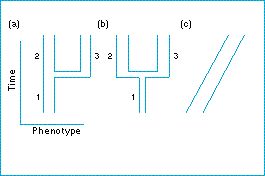The idea of a species - How do we define a species over time?

The cladistic species concept and the non-temporal concepts do not have to be opposed.
By itself the cladistic concept offers no account of what a lineage or a branch point is, whereas the biological and ecological species concepts are inadequate when applied through evolutionary time; they can therefore benefit from the cladistic concept.
We need both a definition of species at a time instant, and a definition for all evolutionary time. At any one time, species may be defined by interbreeding or by a shared ecological niche. If these concepts are applied through time, they lead to arbitrary divisions of lineages; they are therefore best supplemented by a temporal concept in order that they can also be applied through time.
Figure: three patterns of evolution. Time goes up the page. The x-axis represents phenetic distance. In (a) the ancestral species does not change phenetically after a daughter species evolves. In (b) the ancestral species changes after the evolution of the new species: species 1 and 2 are both phenetically and cladistically different. In (c) there is a species that changes gradually through time.
| Next |



